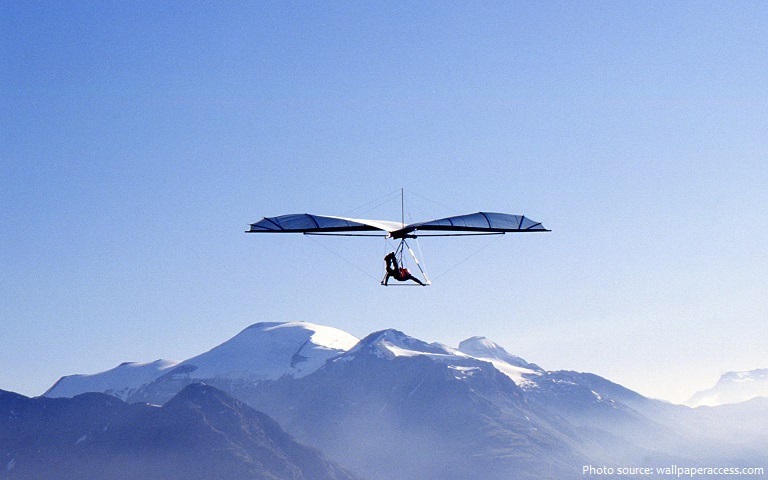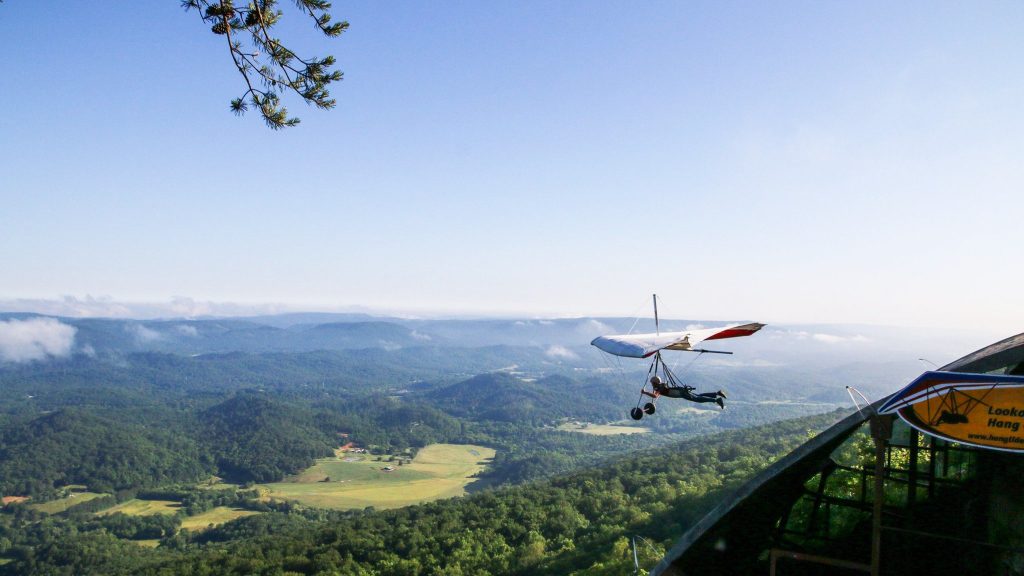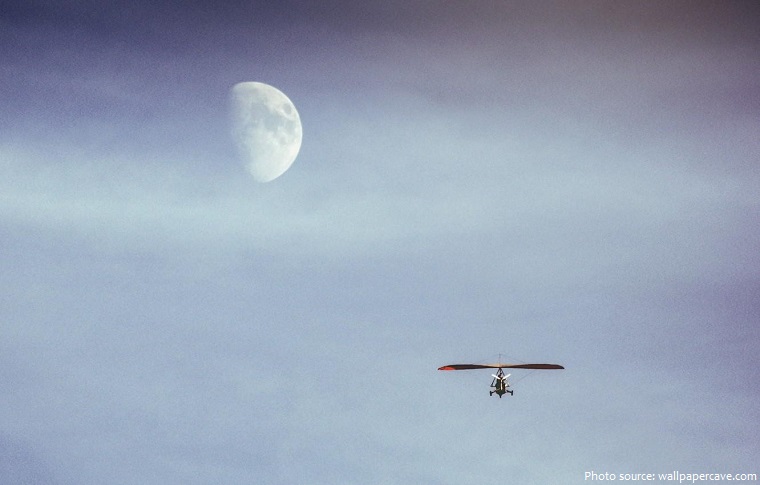
Hang gliding sport of flying in lightweight unpowered aircraft which can be carried by the pilot.
Most modern hang gliders are made of an aluminium alloy or composite frame covered with synthetic sailcloth to form a wing. Typically the pilot is in a harness suspended from the airframe, and controls the aircraft by shifting body weight in opposition to a control frame.
Takeoff is usually achieved by launching into the air from a cliff or hill.
Although gliders normally fly between 20 and 30 mph, they can reach speeds in excess of 80 mph and have a glide ratio of up to 16:1. That means they fly 16 feet forward for every foot of altitude they lose when flying in calm air.

There are four basic aerobatic maneuvers in a hang glider:
Loop — a maneuver that starts in a wings level dive, climbs, without any rolling, to the apex where the glider is upside down, wings level (heading back where it came from), and then returning to the start altitude and heading, again without rolling, having completed an approximately circular path in the vertical plane.
Spin — A spin is scored from the moment one wing stalls and the glider rotates noticeably into the spin. The entry heading is noted at this point. The glider must remain in the spin for at least 1/2 of a revolution to score any versatility spin points.
Rollover — a maneuver where the apex heading is less than 90° left or right of the entry heading.
Climb over — a maneuver where the apex heading is greater than 90° left or right of the entry heading.
Hang gliding can be dated back to the days of Leonardo da Vinci, whose sketchings portrayed his desire for human flight. Through fact and fiction, silent aviation has played a major role in man’s dream to soar with the birds.

In 1853, George Cayley invented a slope-launched, piloted glider. Most early glider designs did not ensure safe flight – the problem was that early flight pioneers did not sufficiently understand the underlying principles that made a bird’s wing work.
Starting in the 1880s technical and scientific advancements were made that led to the first truly practical gliders, such as those developed in the United States by John Joseph Montgomery.
Otto Lilienthal built controllable gliders in the 1890s, with which he could ridge soar. His rigorously documented work influenced later designers, making Lilienthal one of the most influential early aviation pioneers. His aircraft was controlled by weight shift and is similar to a modern hang glider.
In the United States collaboration between Augustus Herring and Octave Chanute resulted in successful flights of a biplane hang glider from dunes in Indiana at the southern end of Lake Michigan in 1896. In these early designs the pilot hung from the armpits on parallel bars beneath the wings, swinging hips and legs to control roll and shifting back and forth to influence pitch.

The hang glider lost some importance from the introduction of wing warping in 1902 by the Wright brothers and subsequently of aileron control by the French. When World War I ended in 1918, the Treaty of Versailles practically ended engine-driven flights in Germany, thus, in the 1920s and 1930s, while aviators and aircraft makers in the rest of the world were working to improve the performance of powered aircraft, the Germans were designing, developing and flying ever more efficient gliders and discovering ways of using the natural air flows in then atmosphere to make them fly farther and faster.
Drawing from the ideas of Leonardo da Vinci, Otto Lilienthal, and the Wright Brothers – Mr. Rogallo, an aeronautical engineer for NASA, created the first flexible wing in the late 1940’s. The wing was unique in that it was inexpensive and easy to build and although it could be deployed like a parachute, it could also glide forward and be steered. The original wing had a glide ratio of 3:1 which meant that for every foot it dropped it would fly three feet forward. The design was revolutionary at the time and although it was used by NASA and the military, it would eventually become famous for its original intent – foot launched personal powerless aviation or hang gliding.

In 1948, aeronautical engineer Francis Rogallo invented a self-inflating wing which he patented on March 20, 1951 as the Flexible Wing, also known as the flexwing and Rogallo wing.
Modern hang gliding emerged toward the end of the 1960s. In the early 1960s enthusiasts in California were gliding down coastal dunes on homebuilt delta-shaped wings they had adapted from kite designs developed by Francis Rogallo and his wife, Gertrude. The Rogallos’ kites had attracted attention because of NASA’s interest in using them for spacecraft retrieval. On the dunes cheap materials such as bamboo and plastic sheeting were used, and the parallel-bar control method remained.
Around the same time, water-ski showmen in Australia were flying on flat kites towed behind speedboats. They were able to control these notoriously unstable flat kites by using swing seats that allowed their entire body weight to effect pitch and roll—a great improvement on the parallel-bar method. When a Rogallo wing was fitted with a swing seat by John Dickenson, in Sydney, Australia, the modern hang glider was born.

By the early 1970s the sport had spread throughout the United States and into Europe. Aircraft-quality materials began to be used, and glide performance increased steadily through improvements in wing and harness design.
Competition is generally based on cross-country soaring, although a trial of a new championship for short-course downhill racing occurred at Mount Olympus, Greece, in 1999.
The farthest out and return distance achieved hang gliding is 410 km (254.76 miles) achieved by Carlos Puñet Pellisé (Spain) and Ralf Miederhoff (Germany) in Bugsdorf, Namibia, on 18 December 2015.

The furthest out-and-return distance hang gliding by a female glider is 229.8 km (142.79 miles) and was achieved by Kathleen Rigg (UK) in Bischling, Austria, on 5 July 2015.
The greatest height gain in a hang glider by a male pilot is 4,359 m (14,301 ft 2 in) by Anton Raumauf (Austria), over Burgsdorf and Helmeringhausen, Namibia, on 3 January 2016.
The greatest height gain in a hang glider by a woman is 3,970 m (13,025 ft) Judy Leden (GB) Kuruman, South Africa, 1 December 1992.